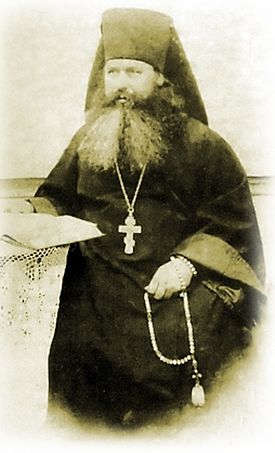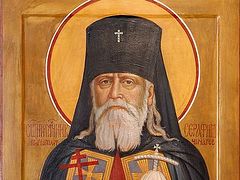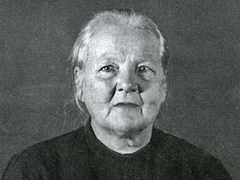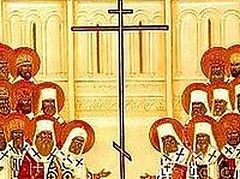Holy Hieromartyr Panteleimon was born June 29, 1872 in the village of Zalipaevka, Fedorovsky county, Malo-Archangelsk region of Orlov province, to the family of peasant Timofei Aranzhykh, and named Pavel in Baptism. The household of the Aranzhykh was poor, and in order to support at least some measure of well being, the father had to work very much. From age twelve Pavel helped his father, was the village shepherd, worked for the landowner, and worked on the side for other peasants. Whenever he was able, he would go to Optina Monastery to pray. In 1894, Pavel was called to active military service and enrolled as a common soldier in the Kamchatka battalion. After duty he was sent to take classes in medical assistance, and after completing them he was appointed as the company paramedic.
In 1898, Pavel was released from the army and began employment in the Zhitomyr province hospital, studying at the same time in the Volhynia paramedical school. After graduating, Pavel Timofeyevich returned to his native land. He lived a half a year at home, pondering what path he should take next—especially since he was by then of an age at which one can and must avoid serious mistakes. He had no family of his own, and his life experience, which came together for him as he observed things around him during army service and paramedical work in a provincial hospital, was sufficient. He recalled then his visits to and prayer in Optina monastery. And although he knew it was strict in the monastery, he had nonetheless grown accustomed to discipline during his four years of army duty.
In 1900, Pavel Timofeyevich headed for Optina and remained there as a novice for around seven years, after which the monastery abbot, Archimandrite Xenophont, tonsured him into the mantia1 with the name Panteleimon in honor of the Great Martyr and healer Panteleimon, taking into consideration his earthly medical profession, and at the same time foreshadowing his future as a martyr. On March 15, 1909, Bishop Benjamin (Muratovsky) of Kaluga and Borovsk ordained monk Panteleimon a priest. In the monastery he had the obedience of paramedic in the monastery infirmary.
In 1915, Fr. Panteleimon was chosen to be the monastery treasurer, and he remained at this obedience until the godless atheists closed the monastery in 1918. For some time he worked on the monastery grounds in the animal breeding center and museum set up by the authorities there, and then he served in the churches of Likhvin, Meshchovsk, and Odoev. In 1925 he came to Kozelzk and served in the St. Nicholas Church. On June 26, 1925, Bishop Joasaph (Shishkovsky-Drylevsky) of Maroyaroslavetz (a vicariate of the Kaluga diocese) raised him to the rank of igumen and appointed him abbot of the Meshchevsk St. George Monastery. But since that monastery was closed by the soviet government, Fr. Panteleimon returned to Kozelsk and served in the St. Nicholas Church.
In those days, hundreds of monks and nuns from closed monasteries—Optina and Shamordino—lived in Kozelsk; they formed a monastery without walls, spread around the town where several monastics had settled into apartment-cells, gathering in church for services that differed little from monastery services.
On Holy Spirit Day, June 9, 1930, according to an old tradition there was an open-air market in Kozelsk, with several thousand people gathered. On that day there was a conflict between the peasants and the militia, during which some peasants were killed. The authorities decided to take advantage of the event to arrest some of the monks, accusing them of inciting rebellion. On August 18, 1930 forty people were arrested, both monks and laypeople, and among them was abbot Panteleimon. He was accused of leading a “monastic-monarchical” group, the aim of which was supposedly to restore the monarchical order. All those arrested were sent to a prison in Sukhinichi.
After the investigator presented the accusations, Abbot Panteleimon said, “I was not the organizer and leader of an underground monastery, nor of a counter-revolutionary monarchical group in the town of Kozelsk. I never gave any instructions or directives along those lines to anyone, and I never participated in those activities. I never conducted any work directed against the soviet authorities… There is not, nor has there ever been an underground monastery in Kozelsk… Why there is such a high concentration of monastics in the town of Kozelsk is not known to me; but I think that the liquidation of Optina and Shamordino Monasteries and the close proximity of Kozelsk forced the monks and nuns to move there. People came from other towns and monasteries for the exclusive reason that there are elders and schemamonks living there, and not because someone has been intentionally occupied with this matter and purposely drew monastics to Kozelsk.2
On November 27, 1930 a “troika”3 from the OGPU sentenced Igumen Panteleimon to ten years of imprisonment, but then the sentence was shortened to five years, and Fr. Panteleimon was sent first to Vishersky Camp, and then to exile in the town of Elets. After finishing his term, in 1935 he got a job as reader in the Church of the Entrance of the Theotokos into the Temple in Elets.
Here he was faced with the relentless persecutions of 1937. Abbot Panteleimon was arrested on September 16, 1937, taken to the Lipetsk prison, and interrogated the next day.
“Do you plead guilty of the accusations brought against you?” the interrogator asked him.
“I do not plead guilty of the accusations brought against me,” the priest answered.
On October 30, the interrogator questioned the witnesses on duty, one of whom stated that supposedly Fr. Panteleimon had complained that, “It has become impossible for the peasants in the collective farm… there is nothing to till with—the horses have all died of hunger… there is nothing to sow because there is no seed in the collective farm; people are dying of hunger and… are eating the dead horses, everyone is threatened with dying from hunger in the near future—that is what communism and the soviet government has brought us to. No matter where you look there is nothing but deceit from this government; they’ve forced the peasants into the collective farms by deceptive means, promising them a wealthy life. But instead they gave them hunger, ruin, poverty, and torment.”4
Another witness stated that while walking home on May 14, 1937, he went into the Church of the Entrance. The evening services were on. At the end of the service, Abbot Panteleimon gave a sermon in which he said that, “Today is a day of sorrow, a day that we are dedicating to our dear and beloved great martyr Peter of Krutitsa, who died at the hands of the enemy—tortured in exile with terrible tortures by our fierce enemies, the enemies of the Russian Church and Orthodox faith… who are leading mankind to hell to the joy of antichrist. This man showed us how a true Christian should live and struggle for the Orthodox faith in such troubled times as are happening now in our Russia. Why did they torture and execute him? The enemies of the Orthodox faith tortured him because they felt his superiority over them, the superiority of religion over communism. At first they tried to persuade him to deny God and the Orthodox faith, to join their side in service to antichrist, but when the Metropolitan of Krutitsa refused to do this, our enemies began torturing him and they tortured him to death. Regardless of any tortures, Metropolitan Peter of Krutitsa refused to serve satan, and he remained faithful to God and the Orthodox faith. I call upon you, the Orthodox, to be just as steadfast as he was, to struggle as he did with the enemies of the Orthodox faith…”5
After these statements by the witnesses the investigator again called in Abbot Panteleimon and again asked whether he pleas guilty to counterrevolutionary activities, at which Fr. Panteleimon answered that he does not—that he has not been involved in counterrevolutionary activities.
On November 15, 1937, the NKVD troika sentenced Fr. Panteleimon to execution by firing squad. Abbot Panteleimon (Arzhanykh) was shot on November 29, 1937 and buried in a common, unknown grave.
Sources used:
1. Case P-13910. UFSB of Russia in Kaluga province.
2. Case 22666. UFSB of Russia in Lipetsk province.




